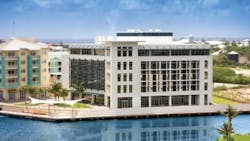With BTU Meters, Planned Community Can Bill Tenants for Actual Energy Use
Developed by Dart Realty (Cayman) Ltd. in collaboration with a team of architects, city planners, landscape designers, and wind, water, and lighting experts, Camana Bay in the Cayman Islands is a planned community consisting of four pedestrian-friendly villages, which include residential neighborhoods, public parks, gardens, and courtyards, along with shops, restaurants, sports facilities, and a school.
Community planners decided on a centralized source of chilled water to cool Camana Bay.
“Once we decided to go with chilled water and a central plant, we needed a way to manage the energy consumption by each occupant throughout the complex,” Richard O’Donnell, facility manager for Dart Realty (Cayman) Ltd., said. “And we wanted the building owners to be able to bill tenants for the actual amount of energy that they consume.”
To accurately measure thermal energy and bill for energy usage, Camana Bay’s engineering team chose a factory-calibrated BTU measurement system from ONICON Inc.
“By acquiring all the information from physical sensors for flow rate and temperature differential, you can not only tell how much energy the tenant is using, you can apply this information to efficiency improvements,” Ken Elander, application engineer for ONICON, said. “Understanding exactly where and when energy is used is the first step towards leading the community as a whole to become more efficient.”
The BTU meters accept signal inputs from two matched high-precision temperature sensors (for supply and return pipes) and a volumetric flow meter. A combination of insertion and inline turbine and electromagnetic flow meters is used. The measurement systems are placed out of the view of building occupants, yet are accessible to maintenance personnel. The data provided include totalized energy, energy rate, volume total, volume rate, supply temperature, and return temperature.
In addition to precise measurement, accurate data collection and trending was a high priority for the metering program. Project engineers recognized the benefit of using a serial network to gather meter data. The System-10 BTU meters connected directly to the Johnson Controls N2 communication network installed as part of the building automation system. Subsequent additions to the community utilized a BACnet MS/TP network, which also is System-10 BTU-supported. Along with providing a more accurate and reliable data-collection method, the serial-network approach avoids costly expansion of the automation system, which would be required with traditional hard-wired analog and digital input points.
In addition to billing building tenants according to the amount of energy they consume, facilities managers can track performance to identify system deficiencies and problems. For example, data from the BTU meters helped to identify a pump that was out of sequence, a problem that otherwise would have gone undetected.
More than 200 BTU meters are in use in the community, and the number is growing. Future phases of development include another commercial building in The Town Centre and a residential neighborhood featuring a mix of condominiums and single-family homes. The comprehensive metering program, including BTU meters, will contribute to LEED certification of these projects.
With comprehensive data concerning chilled-water production and usage available, Camana Bay’s developers know the chilled-water system is readily expandable to meet new construction needs. ONICON BTU meters will continue to provide valuable information about the performance of the cooling system as it grows.
For Design Solutions author guidelines, call Scott Arnold, executive editor, at 216-931-9980, or write to him at [email protected].
